|

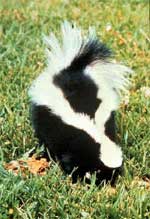 11 Skunks: There are 11 species of skunks, which are divided into four genera: Mephitis (hooded and striped skunks, two species), Spilogale (spotted skunks, two species), Mydaus (stink badgers, two species), and Conepatus (hog-nosed skunks, five species). 11 Skunks: There are 11 species of skunks, which are divided into four genera: Mephitis (hooded and striped skunks, two species), Spilogale (spotted skunks, two species), Mydaus (stink badgers, two species), and Conepatus (hog-nosed skunks, five species).
Sizes and Scales: Skunk species vary in size from about 15.6 in. (40 cm) to 27.3 in. (70 cm) and in weight from about 1.1 lb. (0.5 kg) (the spotted skunks) to 9.92 lb. (4.5 kg) (the hog-nosed skunks) They have a moderately elongated body with reasonably short, well-muscled legs, and long front claws for digging.
Ripe Stripes: Although the most common fur color is black and white, some skunks are brown or gray, and a few are cream-colored. All skunks are striped, however, even from birth. They may have a single thick stripe across back and tail, two thinner stripes, or a series of white spots and broken stripes (in the case of the spotted skunk). Some also have stripes on their legs.

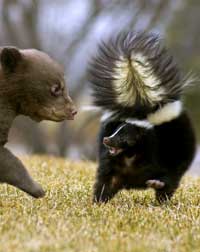 Super Stinkers: The best-known and most distinctive feature of the skunks is the great development of their anal scent glands, which they can use as a defensive weapon. Super Stinkers: The best-known and most distinctive feature of the skunks is the great development of their anal scent glands, which they can use as a defensive weapon.
These Glants Ain't Bland: They have two glands, on either side of the anus, that produce a mixture of sulfur-containing chemicals (methyl and butyl thiols) that has a highly offensive smell. The odor of the fluid is strong enough to ward off bears and other potential attackers, and can be difficult to remove from clothing.
Good Aim! Muscles located next to the scent glands allow them to spray with high accuracy as far as 2 to 3 meters (7 to 10 ft).
Blinded by the Scent: The smell aside, the spray can cause irritation and even temporary blindness, and is sufficiently powerful to be detected by even an insensitive human nose anywhere up to a mile downwind. Their chemical defense, though unusual, is effective.
Using the stink weapon: Skunks are reluctant to use their smelly weapon, as they carry just enough of the chemical for 5 to 6 uses — about 15 cc's — and require some ten days to produce another supply. Their bold black and white coloring however serves to makes the skunk's appearance memorable.
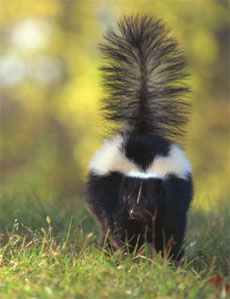 A Last Resort: Where practical, it is to a skunk's advantage to simply warn a threatening creature off without expending scent: the black and white warning co lour aside, threatened skunks will go through an elaborate routine of hisses and foot stamping and tail-high threat postures before resorting to the spray. A Last Resort: Where practical, it is to a skunk's advantage to simply warn a threatening creature off without expending scent: the black and white warning co lour aside, threatened skunks will go through an elaborate routine of hisses and foot stamping and tail-high threat postures before resorting to the spray.
Interestingly, skunks will not spray other skunks (with the exception of males in the mating season); though they fight over den space in autumn, they do so with tooth and claw.
Predators Beware: Most predatory animals of the Americas, such as wolves, foxes and badgers, seldom attack skunks - presumably out of fear of being sprayed.
The exception is the great horned owl, the animal's only serious predator (which, being a bird, has a poor-to-nonexistent sense of smell).
Creatures of the Night: Skunks are nocturnal, and are solitary animals when not breeding, though in the colder parts of their range they may gather in communal dens for warmth. During the day they shelter in burrows that they dig with their powerful front claws, or in other man-made or natural hollows as the opportunity arises. Both sexes occupy overlapping home ranges through the greater part of the year; typically 2 to 4 km² for females, up to 20 km² for males.
For Winter Weather: Unlike the fictional "Flower" in the movie Bambi, real skunks do not hibernate in the winter. However they do remain generally inactive and feed rarely. They often huddle together over winter, with one male and multiple (as many as twelve) females. The same winter den is often repeatedly used.
Skunk Sight: Although they have excellent senses of smell and hearing — vital attributes in a nocturnal carnivore — they have poor vision. They cannot see objects more than about 3 meters away with any clarity, which makes them very vulnerable to road traffic. Roughly half of all skunk deaths are caused by humans, as roadkill, or as a result of shooting and poisoning. They are short-lived animals: fewer than 10% survive for longer than three years.

What's for Dinner? Skunks are omnivorous, eating both plant and animal material but mostly meat. They eat invertebrates (insects and their larvae, found by digging, and earthworms) as well as small vertebrates (rodents, lizards, salamanders, frogs, snakes, birds and eggs). In the wild, skunks forage for food, and in settled areas also seek human garbage.

Love Bites: Breeding usually takes place in early spring. Female skunks are induced ovulators, the male skunk mounts the female from behind and proceeds to bite the female on the back of the neck and back, which induces the female's ovulation.
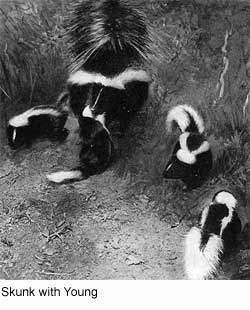 Single Mothers: Females excavate a den ready for between one and four young to be born in May. The male plays no part in raising the young and may even kill them. Single Mothers: Females excavate a den ready for between one and four young to be born in May. The male plays no part in raising the young and may even kill them.
Little Stinkers: A common scene in late spring and summer is a mother skunk followed by a line of her kits. By late July or early August the young disperse. When the young skunks meet again, they raise their tails vertically.
Young Love: After a little posturing they start to rub against each other, often rolling around in what appears to be an embrace. Older skunks seem less friendly to the young kits.

Classification Confusion: Skunks are sometimes called polecats because of their visual similarity to the European polecat (Mustela putorius), a member of the Mustelidae family. Skunks were formerly considered a subfamily of the Mustelidae (where some taxonomists still place them), but recent genetic evidence indicates that they are not as closely related to the weasels and allies as formerly thought.
Stubborn Smell: Removing the scent from objects or creatures can be difficult. Some home remedies suggest using tomato juice, beer or vinegar. A more complex remedy includes application of a mixture containing hydrogen peroxide, baking soda and liquid soap. In an episode of the television program MythBusters, the hydrogen peroxide mix was found to be the most effective smell removal agent.
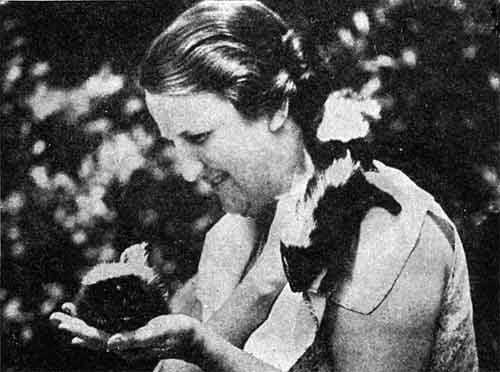
All text is available under the terms
of the GNU Free Documentation License
|